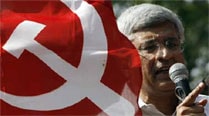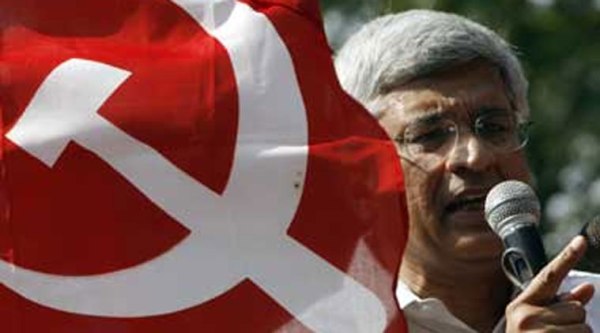Opinion To revive Left, steer clear of Congress
An alliance will damage CPM in its remaining bases, put Left unity under strain

 An alliance will damage CPM in its remaining bases, put Left unity under strain. (Source: PTI photo/PTI)
An alliance will damage CPM in its remaining bases, put Left unity under strain. (Source: PTI photo/PTI)
The present state of the Left in India is a cause for concern, to not only those who are members of the mainstream communist parties but a much wider spectrum of people who are ideologically inclined towards the Left and want it to revive and flourish in order to strengthen secularism, democracy and social justice. The electoral debacle faced by the Left Front in the Lok Sabha polls, especially in its former stronghold of West Bengal, has naturally led to some churning and debate within the Left and its largest contingent, the CPM. The outcome of this debate would have a bearing on the future of the left movement as a whole.
While debating the causes of its decline, however, there is a tendency within the Left to start excavating the distant past, which only leads to endless hair-splitting without any worthwhile conclusions to pursue. For instance, why the communist movement split in the 1960s or the Left as a whole is faced with near extinction in the Hindi heartland are complex issues that do not offer easy answers. What is more relevant and urgent is to first preserve and strengthen the areas where the Left has had a strong presence till date and build up from there.
The main challenge before the CPM today is to stall and reverse its decline in West Bengal. The party has not only failed to recover from the 2011 assembly election defeat, but has continued to suffer a steady erosion of its mass base, progressively ceding even the opposition space to its principal ideological foe, the BJP. The Mamata Banerjee-led government stands thoroughly compromised today because of its outright treachery vis-à-vis the promise of “poriborton” — the change has clearly been for the worse, with corruption scandals, violence, atrocities against women and socio-economic decline engulfing the state. Yet, one has not witnessed a spirited effort by the CPM to raise people’s issues and build a credible, popular movement against the TMC regime. Rather, what is happening is a sharpening communal polarisation alongside the rise of the BJP, which threatens to squeeze the Left out of the political discourse.
The reason behind the inability of the CPM in effecting a turnaround in West Bengal is the obduracy of the party leadership in admitting their errors and ushering in much needed ideological-political and organisational changes. The wounds of Nandigram and Singur continue to fester without any remorse or policy rethink forthcoming from the former chief minister, who remains a permanent absentee from politburo and central committee meetings. The memories of undemocratic highhandedness and corruption under the Left regime refuse to die down in the absence of serious organisational rectification. Just the other day, a senior CPM state leader was interrogated by the CBI in the Saradha case, wrongfooting the party once again on the corruption issue. Muslims, Dalits, Adivasis and women continue to feel alienated from the party, given the lack of any sensitivity towards their issues. While denouncing religious extremism in the wake of the Burdwan blasts, the CPM has not been firm in combating the dangerous campaign to taint the entire Muslim community and madrasas in the state. All of this needs to change.
The strong yearning for change within the CPM at the grassroots level in West Bengal has been stonewalled so far by a status-quoist leadership by invoking a red herring — a proposed alliance with the Congress. This, the argument goes, would enable the Left Front to electorally defeat the TMC in the state, despite the fall in its own voteshare, and also counter the BJP at the Centre. It is this line of reasoning that led the CPM to support the incumbent finance minister of the Congress in the 2012 presidential polls, which divided the Left. With the BJP in power today, a “united front” with the Congress is being pushed even more vigorously.
This line is erroneous at least for three reasons. First, the experience of the CPM-led Left parties in supporting the UPA 1 government from the outside with 60 MPs, between 2004 and 2008, shows that the capacity of the Left to change or influence the ways of the Congress is quite limited. A few welfare schemes notwithstanding, the policy trajectory of the UPA remained neoliberal, with its attendant outcomes in growing inequalities, inflation and corruption. Most of the corruption scandals that were exposed during the tenure of UPA 2 resulted from decisions taken during UPA 1, be it spectrum and coal block allocation or natural gas pricing. The Left had protested against these, but the Congress went ahead anyway. Thus, in order to ally with the Congress once again, the CPM has to ideologically make peace with the neoliberal policy framework, which in turn will destroy its very raison d’être.
Second, the resurgence of the Narendra Modi-led BJP in the general elections and subsequent assembly polls has mainly been
at the cost of the Congress. People across the country are simply disgusted with the Congress not only because of its muddle-headed policies but also because of the corruption, hauteur and cronyism that have become the hallmark of its leadership. The younger generation clearly wants to look beyond the dynastic politics of the Congress, which the AAP experiment in Delhi demonstrated in a limited manner. Efforts to keep the sinking ship of the CPM in West Bengal afloat merely through an alliance with another sinking ship like the Congress can lead to a bigger disaster. What the Left as a whole should aim for is providing a credible and popular alternative to the BJP in future, independent of the Congress.
Finally, the tactical dividend for the Left vis-à-vis an alliance with the Congress is also uncertain. Having lost its mass base in all but a handful of districts in central West Bengal, the Congress has a history of allying with the TMC in the state in successive elections, which can easily get repeated in future. The Left’s alliance offer will only strengthen the Congress’s hands vis-à-vis the TMC in West Bengal. As for Kerala and Tripura, where the Left still has a substantial mass base, the Congress remains its principal rival. An alliance with the Congress will damage the Left in its remaining bases and put its unity under strain.
A sensible course available to the CPM is to attempt a broad-based unity of all left and democratic forces and build an independent left movement in opposition to the right-wing Modi-led regime at the Centre. Besides the smaller leftist parties, there are various social movements with which the Left shares ideological affinity but there exist mutual suspicion and unwarranted hostility. In order to forge such unity, the CPM’s approach needs to be largehearted, democratic and tolerant towards criticism, which many smaller Left parties legitimately have vis-à-vis the big brother. It is through united struggles on public issues, along with vigorous ideological discussions and concrete course corrections, that a vibrant, new Left can emerge in the foreseeable future. Tactical manoeuvres cannot be a substitute for substantive left politics.
The writer was with the CPM till June 22, 2012





